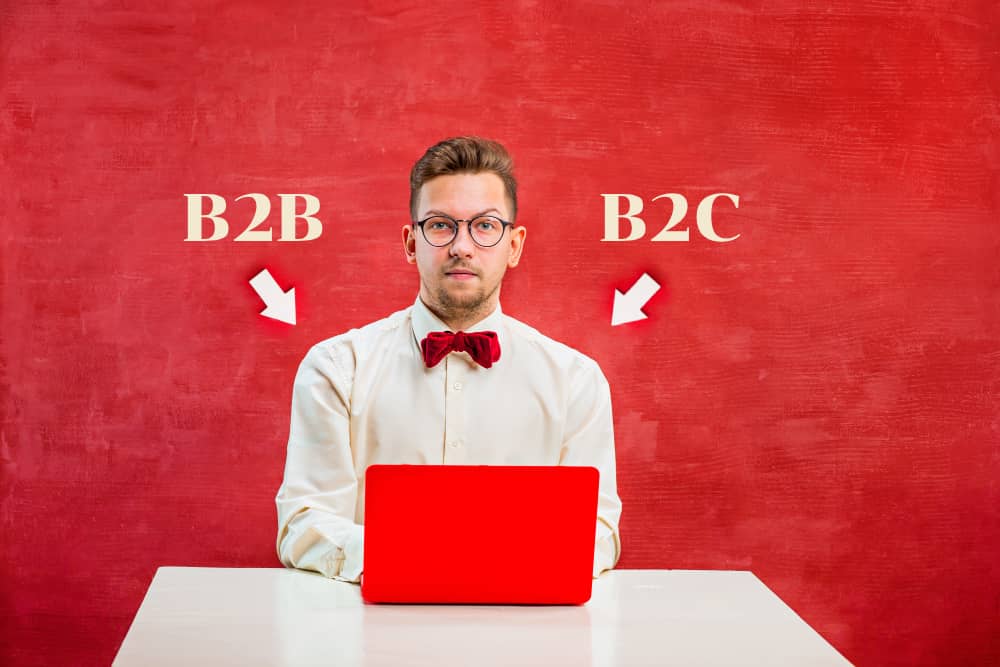
Do you want to connect with potential customers and boost your sales? Well, then, email marketing is essential for your digital marketing mix. Whether you are targeting a business-to-business (B2B) or business-to-consumer (B2C) audience, your strategy may differ significantly. Both have the ultimate objective of turning leads into customers, but the methods for doing so can vary greatly. The main distinctions between B2B vs. B2C email marketing will be discussed in this article, along with advice from email marketing freelancers on designing effective strategies for both audiences.
What is B2B Email Marketing?
Instead of trying to connect with individual customers, B2B email marketing involves sending targeted messages to other businesses. In a particular industry or niche, this kind of marketing is frequently concentrated on fostering relationships and generating leads.
B2B emails may emphasize features and benefits that appeal to business needs, such as cost-effectiveness or increased efficiency, and they frequently use more technical or specialized language than B2C emails. Establishing trust, educating prospects, and ultimately converting them into devoted customers are the ultimate objectives of B2B email marketing.
What is B2C Email Marketing?
B2C (Business-to-Consumer) email marketing is the process of promoting goods or services to specific customers via email. In order to increase brand awareness, lead generation, conversion rates, and customer retention, it aims to establish direct and personalized communication with the target audience.
B2C emails are typically written to be clear, concise, and useful. It frequently entails building segmented email lists, focusing on particular demographics and interests, and sending timely, pertinent messages that speak to the wants and preferences of the audience.
The Differences Between B2B and B2C Email Marketing And How To Take Advantage Of Them
Purchasing Behavior
One of the key differences between B2B and B2C email marketing is the purchase behavior of the target audience. The decision-making process is typically more complex in business-to-business transactions, and the buying cycle is typically longer. B2B emails should therefore emphasize developing relationships, offering insightful information, and educating recipients about how the product or service can help them solve their business problems.
The buying cycle is shorter, and decisions are made more emotionally in business-to-consumer transactions. To appeal to the desires and preferences of the consumer, B2C emails should concentrate on establishing a sense of urgency, providing promotions, and highlighting the advantages of the product/service.
Buying Cycle
Another major difference between B2B and B2C email marketing is the buying cycle. B2B purchases typically involve a longer, more involved process that calls for in-depth research, advice from various decision-makers, and approval. Therefore, B2B emails should include educational and informative content at every stage of the cycle to assist prospects in making informed decisions.
Meanwhile, B2C purchases typically have a shorter cycle and involve impulsive or emotional decisions from the customer. To promote faster purchases, B2C emails should concentrate on generating immediate interest and highlighting the features and value of the product.
Timing
Another big difference between B2B and B2C email marketing is timing. B2B emails should be timed to correspond with essential decision-making phases and are typically sent during business hours. For example, when companies are more likely to plan or assess their needs, this could entail sending emails at the beginning of the week or month. B2C emails, on the other hand, should be timed to correspond with particular occasions or holidays relevant to the audience’s interests and purchasing habits, like seasonal sales or product launches.

Tone of Emails
B2B and B2C emails have very different tones. B2B emails are frequently more formal and businesslike, reflecting the audience’s focus on business. They should concentrate on giving the recipient helpful information and fixing their problems. B2C emails, on the other hand, should sound more casual, reflecting the brand’s personality and creating a personal connection with the reader. B2C emails should entertain and engage the reader while subtly advertising the good or service.
Frequency of Emails Sent
Both B2B and B2C email marketing take into consideration the frequency of emails sent, but the two approaches to frequency are different. Business-to-business emails should be sent less frequently because businesses receive many emails daily. Businesses should concentrate on sending their target audience individualized, high-quality content marketing at particular points in the buying cycle. Too many emails sent may result in decreased engagement and a rise in opt-outs.
B2C emails, however, can be sent more frequently due to the lower likelihood that consumers will receive a large number of promotional emails. Brands should entice their audience to buy by providing them with relevant content and promotions. A decrease in engagement and even unsubscribes could occur if B2C customers receive too many emails. For each target audience, it is essential to strike a balance and determine the best frequency.
Type of Content
B2B and B2C email marketing use very different types of content. B2B emails should concentrate on giving the recipient useful information and fixing their problems. Whitepapers, case studies, and thought leadership articles are examples of content. B2B emails should be instructive and educational while showcasing the company’s domain knowledge.
B2C emails, on the other hand, ought to be more casual and concentrate on entertaining the audience and nurturing leads. Content options include personalized recommendations, discounts, and product promotions. In addition, B2C emails ought to work to establish a personal rapport with readers and showcase the brand’s personality. Businesses can boost engagement and forge closer bonds with their clients by adjusting the type of content to the specific target audience.
Strategies For B2B Email Campaign
Profile Your Target Customers
For B2B email campaigns, creating a customer profile of your target audience is a crucial strategy. You can create personalized and relevant content that resonates with your target customers by understanding their needs, problems, and objectives. You can potentially achieve higher open rates, click-through rates, and conversions thanks to this strategy.
Businesses should research their target market, look at customer data, and use segmentation to put customers into groups based on the traits they have in common. Your B2B email campaigns can be tailored to your target customers’ unique needs and preferences by profiling them, improving your marketing initiatives’ effectiveness.

Email Segmentation
An effective B2B email campaign strategy is the use of email segmentation. You can give your audience more individualized and relevant content by segmenting your email list into smaller, more focused groups based on shared traits, like industry or job role. Higher engagement and conversion rates may result from this.
Businesses can use a variety of segmentation factors, such as customer lifecycle stage, behavior, and demographics. You can better target your messaging and offers to each group’s unique needs and preferences by segmenting your email list, which will increase the likelihood that your B2B email campaigns will be successful.
Save Time By Automating
Businesses can save time and money by automating their B2B email campaigns, which also boosts productivity and effectiveness. By setting up automated workflows, they can send tailored emails to their target market based on specific actions or behaviors.
For instance, following up with a personalized offer to leads who have interacted with your website or content or sending a welcome email series to new subscribers. Your team will be able to concentrate on high-priority tasks while still providing timely and pertinent communications to your audience with the help of automation, which can also help streamline lead nurturing and sales processes.
Strategies For B2C Email Campaign
Customer Purchasing Behavior
Businesses need to understand B2C customers’ purchasing habits in order to effectively engage with them. Then, they can send targeted and customized email campaigns that appeal to specific customer interests and preferences by tracking and analyzing data like purchase history, abandoned cart items, and website browsing behavior.
Strategies like upselling, cross-selling, and personalized product recommendations can also be used to promote repeat purchases and boost customer loyalty. Businesses can also use email campaigns to inform customers about sales, discounts, and limited-time offers that match their interests and buying habits, further encouraging them to purchase.
Mobile Optimization and CTA
Mobile optimization is essential for a B2C email campaign to be as effective as possible. Your email templates must be responsive and mobile-friendly because more than 50% of email opens take place on mobile devices.
Additionally, including calls to action (CTAs) that are crystal clear and persuasive can aid in boosting conversion rates. Make sure your email’s CTAs are easy to find and prominently displayed. To make your email visually appealing, keep the content brief and to the point and add eye-catching graphics and images.

Retargeting
Retargeting is an effective strategy for B2C email marketing campaigns. You can re-engage website visitors who didn’t convert on their first visit by tracking them and sending them personalized emails based on their behavior.
Reminders about abandoned carts, product recommendations, and customized offers are some examples of this. Retargeting enables you to boost the efficiency of your email campaigns and increase conversion rates. Just make sure to target well and refrain from over-emailing your audience, as this can cause email marketing fatigue and unsubscribes.
Conclusion
Despite the fact that B2B and B2C email marketing do share some similarities, there are enough differences to call for different approaches. While B2C campaigns should put an emphasis on eye-catching graphics and personalized messaging, B2B campaigns should concentrate on fostering relationships and providing useful content.
Whatever strategy you choose, always keep in mind that the best way to ensure success is to segment your audience, optimize for mobile, and monitor your metrics. You can maximize the impact of your email marketing efforts and accomplish your business objectives by customizing your campaigns to your audience’s unique needs and preferences.
About the Author
 Velislava Georgieva is a Digital Marketing Specialist at Inbound Blogging, specializing in Content Marketing and Outreach Strategies. Besides her passion for digital marketing, she likes yoga, fitness, and hiking. You can connect with her on LinkedIn.
Velislava Georgieva is a Digital Marketing Specialist at Inbound Blogging, specializing in Content Marketing and Outreach Strategies. Besides her passion for digital marketing, she likes yoga, fitness, and hiking. You can connect with her on LinkedIn.